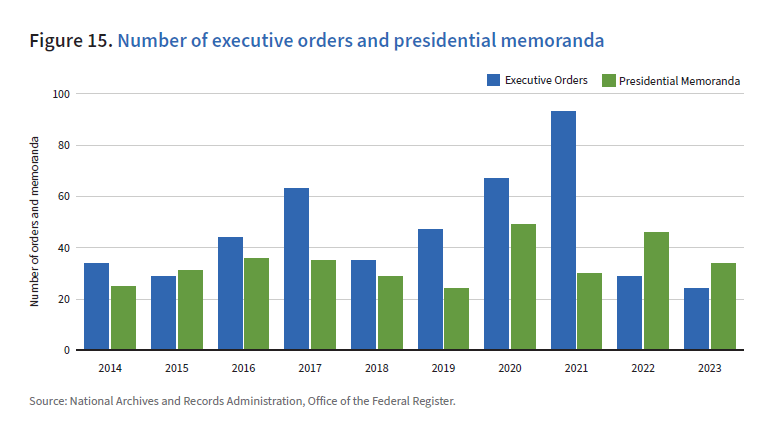Chapter 5: Regulatory dark matter: Executive orders and memoranda
Although executive actions ostensibly deal with the internal operations of the federal government, they increasingly can have binding effect and influence private behavior. Executive orders, presidential memoranda, notices, “fact sheets,” and other proclamations make up a substantial component of policymaking, and in part may explain some of the counterintuitive decline in rule counts even as federal scope expands in spending, contracting and procurement, and greater economic intervention, and public–private partnerships, such as the aforementioned forays into supply chains, hydrogen hubs, and blueprints for artificial intelligence. Presidents of both parties routinely threaten unilateral executive actions if Congress fails to act on their agenda.
Executive orders
Executive orders (EOs) date back to George Washington’s administration, but their numerical cataloging and archiving has not been consistent until recent decades. Since the nation’s founding, presidents have issued at least 15,635 of them (see Appendix G).
The United States was several decades old before a president issued more than two dozen executive orders as did President Franklin Pierce (1853–1857). Orders numbered in the single digits or teens until President Abraham Lincoln’s federal consolidations and the subsequent Reconstruction period. President Ulysses S. Grant’s total of 217 set a 19th-century record.
From the 20th century onward, executive orders have numbered over 100 during every presidency and have sometimes soared into the thousands. President Franklin D. Roosevelt—the longest-serving president in history, elected to four terms and serving a full three—issued 3,467 executive orders.

The 93 executive orders in 2021 stand out in Figure 15. Joe Biden issued 77 of that total, whereas Trump issued 16. Biden’s total fell to 24 in 2023. Recognizing that overlap occurs in transition years, here are calendar-year breakdowns of total and average annual executive orders published in the Federal Register during recent administrations:
- Bill Clinton (eight years): 364 executive orders, average 46 per year
- George W. Bush (eight years): 291 executive orders, average 36 per year
- Barack Obama (eight years): 276 executive orders, average 35 per year
- Donald Trump (four years): 220 executive orders, average 55 per year
Biden’s three-year average so far is 43. His 24 executive orders from 2023 reflect the aforementioned whole-of-government efforts and include the following:
- Further Advancing Racial Equity and Support for Underserved Communities Through the Federal Government (EO 13091), February 22, 2023
- Reducing Gun Violence and Making Our Communities Safer (EO 14092), March 17, 2023
- Prohibition on Use by the United States Government of Commercial Spyware That Poses Risks to National Security (EO 14093), March 30, 2023
- Modernizing Regulatory Review (EO 14094), April 11, 2023
- Revitalizing Our Nation’s Commitment to Environmental Justice for All (EO 14096), April 26, 2023
- Authority to Order the Ready Reserve of the Armed Forces to Active Duty to Address International Drug Trafficking (EO 14097), May 1, 2023
- Moving Beyond COVID-19 Vaccination Requirements for Federal Workers (EO 14099), May 15, 2023
- Federal Research and Development in Support of Domestic Manufacturing and United States Jobs, August 3, 2023 (EO 14104)
- Safe, Secure, and Trustworthy Development and Use of Artificial Intelligence (EO 14110), November 1, 2023
Executive orders sometimes aim at regulatory review in addition to their popularity for implementing policy. Bill Clinton’s 1993 Executive Order 12866 retained the Office of Management and Budget (OMB) central regulatory review function established by Ronald Reagan’s EO 12291, but sought “to reaffirm the primacy of Federal agencies in the regulatory decision-making process.” Joe Biden’s “Modernizing Regulatory Review” (EO 14094) noted in the foregoing list eliminated the streamlining of Trump’s EO 13771, Reducing Regulation and Controlling Regulatory Costs.
Although superficially retaining the Clinton review structure, Biden’s EO 14094 raised the threshold for a significant regulatory action from $100 million annually to $200 million, a floor that will ratchet upward alongside increases in GDP. Even more significantly, EO 14094 transformed the OMB’s Circular A-4 and subsequent guidance on regulatory review to soften oversight and enlist OMB instead in allegedly net-beneficial regulatory pursuits.
Presidential memoranda
Presidential memoranda and notices are trickier to tally than executive orders. They may or may not be published in the Federal Register or other readily accessible sources depending on a given administration’s own determination of “general applicability and legal effect.” Nor are memoranda, determinations, notices, proclamations, presidential orders, and other documents reliably classified or numbered the way executive orders are.
These decrees can range from minor declarations celebrating events or people to the more momentous and unilateral like a 2022 continuation of the national emergency concerning COVID-19, proclamations expanding national monuments by hundreds of thousands of acres (thereby prohibiting any form of private industrial or commercial activity in those lands), or actions affecting gun dealers involving background checks and serial numbers.
As Figure 15 shows, Biden issued 46 memoranda in 2022 and 34 in 2023. Apart from Trump’s 49 in 2020, 2022 marks the highest single-year count to appear in the Federal Register database, which records totals back to 1994. Appendix M (The Unconstitutionality Index) discussed later depicts annual totals of both executive orders and memoranda over the past two decades.
Recognizing that overlap occurs in transition years, here are calendar-year breakdowns of total and average memoranda published in the Federal Register by recent administrations:
- George W. Bush (eight years): 129 memoranda, average 16 per year
- Barack Obama (eight years): 255 memoranda, average 32 per year
- Donald Trump (four years): 137 memoranda, average 34 per year
- Joe Biden (first three years):110 memoranda, average 37 per year.
The following are among Biden’s 34 memoranda from 2023:
- Further Efforts to Protect Access to Reproductive Healthcare Services, January 26, 2023
- Supporting Access to Leave for Federal Employees, February 7, 2023
- Presidential Waiver of Statutory Requirements Pursuant to Section 303 of the Defense Production Act of 1950, as Amended, on Department of Defense Supply Chains Resilience, May 2, 2023
- Conserving the Natural and Cultural Heritage of the Pacific Remote Islands, May 30, 2023
- Certification Regarding Disclosure of Information in Certain Records Related to the Assassination of President John F. Kennedy, July 7, 2023
- Restoring Healthy and Abundant Salmon, Steelhead, and Other Native Fish Populations in the Columbia River Basin, October 2, 2023
- Modernizing United States Spectrum Policy and Establishing a National Spectrum Strategy, November 17, 2023
- White House Initiative on Women’s Health Research, November 17, 2023
The pertinent question regarding federal intervention is what these executive orders and memoranda do, and the authority or lack thereof used to justify them.
